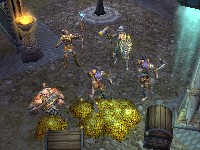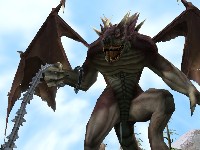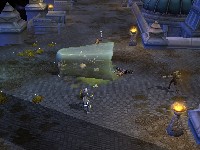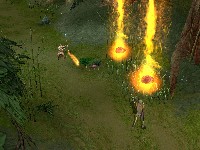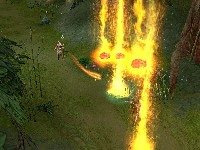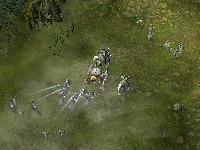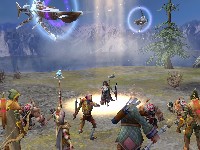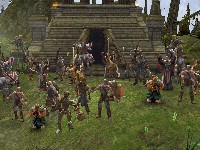Genre: RPG/RTS
Publisher: Atari
Developer: Liquid Entertainment
Release Date: Summer 2005
One of the weirder revelations coming out of this year's E3, if you're as big a damn nerd as I am – and you aren't, so don't even try to step to this – is that the new Dungeons & Dragons PC games -- Dungeons & Dragons Online and Dragonshard -- are set on, of all places, Eberron.
This is one of the few memorable campaign settings to come out since D&D's third edition hit shelves, because it is, in a way, a fantasy world taken to its natural conclusion. D&D campaign worlds tend to be stuck in a vaguely feudal period, and have a moderately black-and-white view of morality. Eberron's more like 19th-century Europe with magic in it, and it mostly deals with shades of gray.
Dragonshard is the first D&D-themed real-time strategy game. The title refers to a ring of magical stones that surrounds Eberron. When a dragonshard falls to earth, it can be used as a battery to power a variety of magical items, such as Eberron's massive airships.
The titular Dragonshard is known as the Heart of Siberys, a massive and ancient artifact that's turned up in the Xen'drik region. Xen'drik has been shielded from outsiders for thousands of years by impassible mountains and a never-ending series of storms.
Three separate factions send armies into Xen'drik to claim the Heart. One is the Order of the Flame, a company of priests and crusaders; another is the Lizardfolk, an army of drakes, salamanders, lizardmen, and other scaly things. The third is, as of press time, apparently meant to be a secret, but isn't initially usable in the singleplayer mode.
It's tempting, at this point, to think of Dragonshard as a sort of Eberron-flavored Warcraft skinmod, but it's remarkably faithful to its source material. It's also the result of a deliberate attempt to “bend and [break] the rules of real-time strategy,” to quote one of Liquid's designers.
When you start the game, you'll come preequipped with an upgradeable city square, with space to build about sixteen facilities inside. You can construct towers to help defend the city, but more importantly, the city walls prevent the easy use of idiot-simple instant-win strategies. There's no such thing as a huntress rush in Dragonshard.
There aren't any worker units to claim resources. Instead, you'll slowly gain these by taxing your property. Your troops can also go and claim resources, such as gold and smaller dragonshards, on your behalf. This is where the other half of the game comes into play.
Dragonshard is set on two levels: aboveground and underground. In the aboveground game, you train troops and dispatch armies much as you do in other RTS games. With the limited available city space, you'll need to carefully pick and choose what facilities you want to use.
Instead of generating a bunch of troops, you'll field an army that's comprised largely of squads. Each side can field a single champion to lead their forces, and generate captains from their cities. Each captain can produce up to six lesser soldiers to follow him, which'll pursue him and do what he does. Finally, if you have the tools to do so, you can produce a massively powerful, unique unit called a juggernaut.
For example, one of the Order of the Flame's champions is a priestess of the order. They can also field a powerful dwarven barbarian, who can call up to six other barbarians to his side. Their juggernaut is a phoenix, which literally rains fire down upon the enemies it encounters.
In the underground game, you can dispatch your champion and captains into subterranean passageways. Here, you'll find new treasures, gather champion artifacts to permanently power up your commanders, seize places of power to provide upgrades for your army, and encounter a selection of infamous monsters from Dungeons & Dragons. You can expect to run into anything from a gelatinous cube to a beholder in Dragonshard's dungeons, and all of them look exactly like they do in the books. You can actually zoom in on the gelatinous cube and see the remnants of its past victims floating inside.
Of course, you'll gain experience points during your dungeon crawls. In Dragonshard, XP are treated almost like a resource. You can spend XP to level up individual units, with accompanying improvements in their stats and abilities.
I'm not much of an RTS fan, but I am a big D&D geek of many years' duration. Dragonshard could've easily been a quick cash run on the license, but it's a game I could honestly see myself playing. I'll be looking forward to seeing how the final version turns out.
More articles about Dragonshard











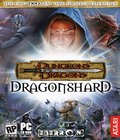 Lead your warriors underground, to thrilling RPG-style dungeon campaigns that affect the myriad maneuvers above. Control armies of haunting power from another time, another plane, another bloodline, in this innovative fantasy experience from the legendary worlds of Dungeon & Dragons.
Lead your warriors underground, to thrilling RPG-style dungeon campaigns that affect the myriad maneuvers above. Control armies of haunting power from another time, another plane, another bloodline, in this innovative fantasy experience from the legendary worlds of Dungeon & Dragons.



